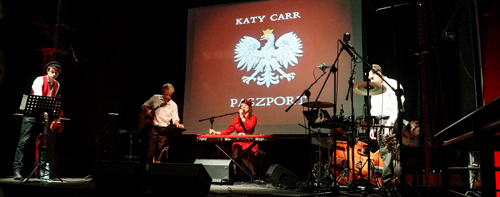
Katy Carr and the Aviators perform at the Warsaw Uprising Museum, Oct. 2013
Photo by Aleksandra Sędek
Since I last chatted with Katy Carr, she’s starred in a Warsaw Uprising Museum concert, sung Leonard Cohen’s “Hallelujah” at Warsaw’s 13th Papal Day, and performed at Polish Cultural Centres in Lublin, Kraśnik and Świdnik. That was just in October.
Earlier this year, she attended Quo Vadis conferences in Montreal and Connecticut, and had numerous performances around her native Britain, the U.S. and Canada.
When we spoke via Skype, she’d just returned from a three-week tour of Poland. We chatted about that trip and her upcoming album, what she’s reading and – since we’re both huge clothes buffs – her latest vintage finds. We also discussed why it’s so crucial that the Polish history she sings about and I write about be more widely known.
* * *
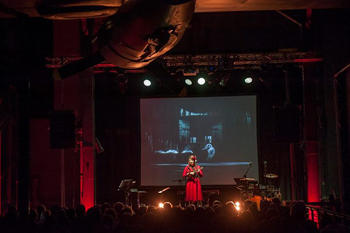
Katy performs at the Warsaw Rising Museum, Oct. 2013. The Liberator plane is suspended above Katy on the top left.
Courtesy of the Museum
What was it like performing at the Warsaw Uprising Museum? I’ve been there – it’s stunning.
It is. I was in the hall with the Liberator plane. That was the plane that inspired my song “Motylek,” about pilots in the WWII. I wrote that song after I visited the Museum, because Kazik, [Kazimierz Piechowski, the true-life hero of her song Kommander’s Car] told me to go there.
We collaborated with the museum for the concert, so we were able to show archival footage of the Polish Warsaw Uprising soldiers.
There was a crowd of over 300 people. I had this girl make me a hat – a wonderful, 40s hat. The same girl had learnt all the lyrics of my songs and her copy of [my album] Paszport was so faded. I had three standing ovations as well, so that was wonderful.
I was also on TV and radio. Polish journalists, they are very moved but then also can’t quite understand why I’m there. They ask me, “Why are you here? Why are you doing this?” They can’t understand why a British singer would come and want to sing in Polish. But then the audiences are extremely moved that I’m singing in Polish. For them, a lot of these stories are untold, a lot have not been talked about.
When you come to my concerts, you can really feel the energy of the audience transmitting this complete support. A lot of people cry and they want to tell me their stories afterward. It’s this overwhelming sense that what we’re doing is very important for the people in Poland. I hope that doesn’t sound too dramatic. It definitely is having an effect.
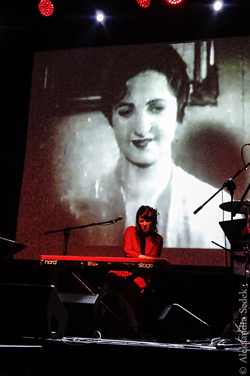
Archival photo of a Warsaw Uprising fighters projected on the screen behind Katy during the concert
Photo by Aleksandra Sędek
When I studied in Poland, I got the same question: Why? Why would an American want to come to Poland? I would explain: There are things here that I don’t have in America. And there’s a history here that I’m drawn to. I feel that on one hand that because Poland has dealt with the war so much Poles don’t want to talk about it, and yet – like you said – there are still so many stories that are untold and we haven’t talked about them enough.
It is a question that I’m starting to ask in my creative life and it’s a question that has moved me quite significantly. [My album] Paszport was very much concerned with the very big Polish patriots who had not been able to have a paszport, a Polish passport, during WWII and after. There was no Poland during WWII, because it was under German and Soviet occupation. I don’t think a lot of people understand that.
I am on this massive creative journey to try to uncover why it’s important that I have Polish blood. For a long time, a lot was silenced about Poland. And now Poland is independent again. And the eagle does have the crown on its head, which I put on my album cover. (Author’s note: When communists took control of Poland after WWII, they stripped the white eagle, Poland’s national coat-of-arms, of its crown so that all national emblems had a crownless eagle – a symbolic note to remind Poles of their loss of power.)
There’s a huge 1000+ years of history that has kept this little country on the map. Superpowers, Russia and Germany, tried to erase it but it’s managed to keep its customs and its heritage.
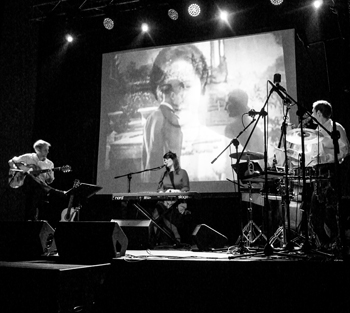
Archival photos of the Warsaw Uprising were projected on a screen during the concert
Photo by Aleksandra Sędek
Why do you think these stories have remained untold for so long?
A lot of the reason is the political climate. After WWII, people couldn’t return home, they couldn’t tell their stories. They were worried that their families might be taken to Siberia or branded by the KGB.
A lot of the people had been in tremendous shock from being in concentration camps and terrorized and tortured. So there’s been a lot of terrible fear in the Polish community, and this has contributed to a decreased confidence in their achievements. Propaganda [kept] working to keep people in fear.
Now we only have a few years left of veterans and so it’s really high time that we acknowledge this history.
As a member of Polonia, the Polish Diaspora abroad, this is something I would like to raise in Great Britain: why [Poland’s] presence in our museums, our public institutions should be further acknowledged. In our Science Museum there’s a huge exhibit on the Enigma machine and not one of the Polish mathematicians is even mentioned.
We have to address this. It’s a point of enhancing and opening channels. The RAF Museum has done incredible things for Polish pilots, they’ve had amazing exhibitions, the RAF Museum in Hendon has given us materials to show at our concerts.
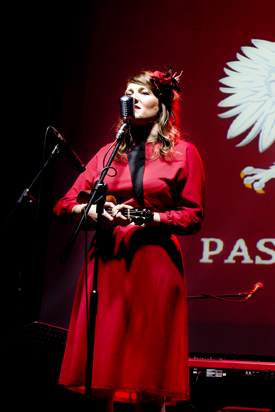
Katy at the Warsaw Uprising Museum, Oct. 2013
Photo by Aleksandra Sędek
What would it be like if these stories were more known? What would change?
Any information that shows a positive reflection on history that elevates people’s morale and raison d’etre on this earth can be inspiring for many nations.
The idea that Polish history could be shared on a daily level is so exciting. Polish history is remarkable and very inspiring. When you find out about all these incredible characters who defied history by being so progressively defiant – they’re great rebels. Polish people are a nation of great achievers and thinkers.
Maybe this is why you keep getting asked, “Why?” You’re butting up against forces that have been in place for decades.
When I wrote my album [Paszport], it was a love letter to Poland. I did know that Polish people would be moved, but I had no idea the level that they would be moved. It is such a joy to be able to sing and have people sing your songs and have real meaning. That’s very beautiful and something I will always treasure.
One of the things I think about is I’m not my parents’ generation that had to carry the weight of WWII. I’m removed. For me, I see the inspiration and I can celebrate. I can be an author of renaissance, not an author of requiem.
What am I? Am I Polish, British, who am I? I’m a 21st century hybrid, I can be anything. That’s quite an important point. All these questions I’m going to be thinking about for next album.
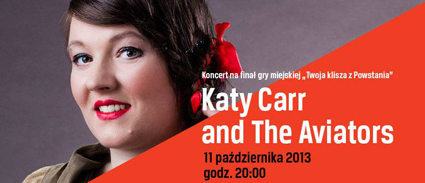
Warsaw Uprising Museum ad for Katy’s Oct. 2013 concert
CR’s editor, Irene Tomaszewski, met you at the Quo Vadis Conference in Montreal; she looked up during a presentation and saw a lovely woman with a red flower in her hair who looked familiar – and soon realized it was you! Her favorite song of yours is ‘Mała, Little Flower.’ Tell us about it.
It’s about a lady called Irena Gut Opdyke who saved 12 Jewish people in the basement of an SS man’s house in WWII. It’s about the day Irena’s fiancé was killed in action before her wedding day in 1944.
Irena had to become the concubine of this SS man after hiding the Jewish people in the basement for two years. He discovered them one day. He’s 70 and she’s 17. She didn’t tell the Jewish people. Afterwards, they said they would have rather been shot than have her be his concubine. Her response was, it was a little price to pay for saving my friends’ lives. I’d like to lay flowers on her memorial stone in Yad Vashem.
Most people who saved Jewish lives were Polish. They are predominant in Yad Vashem. It goes to show how loyal Polish people were to Jewish people during the WWII, and it raises huge questions about why Poland has been subjected to this propaganda about being anti-Semitic, when it was a country that was very tolerant of other religions. Which is something to be contested, because it’s not something that any Polish person would want to be associated with, I believe.

Katy Carr performs at the Warsaw Uprising Museum, Oct. 2013
Photo by Aleksandra Sędek
What’s next for you?
I’m preparing a collaboration with an Ethiopian singer where I’ll be doing Polish songs with Ethiopian songs, intertwined. It’s in connection with Refugee Week.
I can’t give you her name; she’s a refugee. The same issues face this singer as faced the Polish people in WWII. I was talking to her about the Polish refugees and about the Warsaw Uprising, and her face was very, very sad. She understood. Even though it’s 70 years ago, she can relate.
When we finished the meeting, she said, ‘I love the sound of Polish history because it’s like my history.’ She’s very fascinating but more on that next year.
Next month I’m going to Belfast, Mexico and potentially, California.
In 2014, I want to do a tour of Polonia in America and Canada and visit the Polish communities there.
I’m looking forward to doing events around the major commemoration dates, 70th anniversary of Monte Cassino, 70th anniversary of the Warsaw Uprising.
I am aiming for my record to be out on the first of September next year. Looking forward to sharing more untold stories on Poland but also sharing what is incredibly alluring about this little country and how proud I am to have Polish blood.
* * *
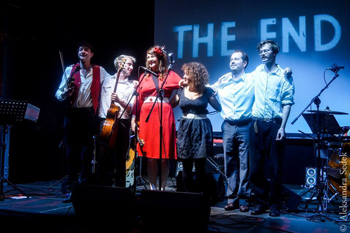
Katy and the Aviators take a bow at the Warsaw Uprising Museum, Oct. 2013
Photo by Aleksandra Sędek
As we wrap up, I ask Katy if she’s bought any new shoes or clothes lately; I saw on her Facebook page that she’d recently snagged some great WWII-era Mary Jane’s.
“I’m completely obsessed with clothes, especially vintage clothes,” she says. “I don’t like modern clothes, they don’t fit my figure.”
She shows me a floor-length, sky-blue coat with rounded sleeves and a tapered waist with all sorts of nips, tucks and detailed embroidery on the front panels.
“It’s the most beautiful thing I’ve ever seen in my life, nearly,” she says. “I mean, I say that about everything I buy. It’s going to be for a show. It’s got wheat [embroidery] on it, the symbols of Poland.”
She has various haunts she scours for vintage pieces; one is Blackout on Endell Street in London. She also visits vintage fairs regularly, and gets pieces as gifts.
“This is probably from the 1930s.” She lifts up a deep black, floor-length lace dress with feathers that cascade down from the knees down, and enormous tulle sleeves. It belonged to a friend’s aunt.
Katy models the hat she received from a fan at the Warsaw Uprising Museum. It’s a white toque that sits on one side of her head and looks perfect.
As we say our goodbyes, she shows me the books she’s reading: Adam Zamoyski’s Poland, Tadeusz Konwicki’s The Polish Complex, Halik Kochanski’s The Eagle Unbowed (she says that huge number of Russian rapes of Polish women during the war made her feel sick).
“I’m going to be reading about my hussars now,” Katy says. The Polish Hussars, who reigned as an elite cavalry between the 16th and 18th centuries, are often referred to as the Winged Horsemen of Poland. They wore wooden arcs attached to the back of their armor; the arcs had feathers that would make a fearsome noise as the hussars flew across the plains on their horses.
“I have to write a song about the hussars because they’re extremely attractive,” she concludes. “That’s my lesson today.”
CR
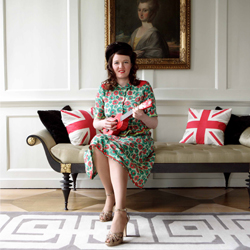



Rock on, Katy! I’m glad to see you have gigs all over the world coming up.
Me too! And I really hope that one of those gigs turns out to be D.C.
We were very excited to have Katy Carr join a Kresy-Siberia “Salon Soiree” in Warsaw at Smolna 14 on 23 September. )photo: https://www.facebook.com/photo.php?fbid=523186757757659&set=a.516649255078076.1073741831.133136766762662&type=3&theater)
We have submitted a grant application to Poland’s Ministry of Foreign Affairs for a 24-stop concert tour with Katy in 2014, and hope to have a positive announcement in mid-February.
Go Katy!!!
Pingback: Katy Carr's Nov/Dec 2013 Newsletter - Katy Carr